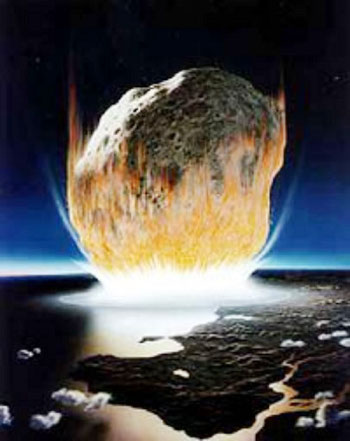
Asteroid Deflection
April 19, 2012 One characteristic of modern laboratories is the plethora of warning signs. We see warnings about high voltage, X-rays, toxic chemicals, toxic gases, and so forth. As they say, "A word to the wise is sufficient" (Verbum sapienti satis est). The Earth has a proximate warning sign, also. The cratered surface of the Moon warns us that we live in a dynamic solar system in which celestial bodies frequently pummel each other. There's an interesting episode of Star Trek (Season 3, Episode 3), entitled The Paradise Syndrome (October 4, 1968, Jud Taylor, Director) that deals with a potential asteroid impact on a primitive civilization.[1] Not even Spock, with all the power of the Enterprise, could divert an asteroid on a collision course with this populated planet. The primitive people were saved by a device put there in a distant past by an alien race. The device successfully deflected the asteroid. The Earth, unfortunately, does not have any alien asteroid deflectors, so we need to handle things ourselves. | There goes the neighborhood! This is an artist's illustration of a supposed asteroid impact on Earth about 250 million years ago. This impact, off the northwestern coast of Australia, left a 125 mile diameter crater and caused massive extinctions. (NASA image, Continental Dynamics Workshop/NSF). |
| Impulsive Technique | Description |
| Conventional Explosive (surface) | Detonate on impact |
| Conventional Explosive (subsurface) | Drive explosive device into PHO, and then detonate |
| Nuclear Explosive (standoff) | Detonate on flyby using a proximity fuse |
| Nuclear Explosive (surface) | Impact, detonate using a contact fuse |
| Nuclear Explosive (delayed) | Land on surface, detonate at an optimum time |
| Nuclear Explosive (subsurface) | Drive explosive device into PHO, and then detonate |
| Kinetic Impact | High velocity impact |
| Slow Push Technique | Description |
| Focused Solar | Use a large mirror to focus solar energy on a spot to vaporize material |
| Pulsed Laser | Rendezvous, position spacecraft near PHO and focus a laser on surface to vaporize material |
| Mass Driver | Rendezvous, land, attach, mine material and eject material from the PHO at high velocity |
| Gravity Tractor | Rendezvous with PHO and fly in close proximity for extended period, Gravitational attraction provides a small force |
| Asteroid Tug | Rendezvous with the PHO, attach to the PHO and push |
| Yarkovsky Effect | Change the albedo of a rotating PHO. Radiation from sun-heated material will provide a small force as the body rotates |
References:
- The Paradise Syndrome, Star Trek (Original Series), Season 3, Episode 3, October 4, 1968, Jud Taylor, Director, on the Internet Movie Database.
- Massimo D'Orazio, "Meteorite records in the ancient Greek and Latin literature: between history and myth," Geological Society, London, Special Publications, January 1, 2007, vol. 273, pp. 215-225.
- Rob Waugh, "Bus-sized asteroid hurtles past Earth - so close it flew UNDER the moon," Daily Mail (UK), April 2, 2012
- Asteroid 2012 DA14 Page on Wikipedia.
- Report to Congress: Near-Earth Object Survey and Deflection Analysis of Alternatives, National Aeronautics And Space Administration, March 2007.
- Final Report of the Ad Hoc Task Force on Planetary Defense, NASA Advisory Council, Dr. Tom Jones and Mr. Rusty Schweickart, Co-Chairs, October 6-7, 2010.
- Engineers set their sights on asteroid deflection, University of Strathclyde Press Release, March 25, 2012.
- Neil deGrasse Tyson, "We Can Survive Killer Asteroids — But It Won't Be Easy," Wired, April 2, 2012.
- Neil deGrasse Tyson Cameo appearance on The Big Bang Theory (YouTube video clip).
- Massimo D'Orazio, "Meteorite records in the ancient Greek and Latin literature: between history and myth," Geological Society, London, Special Publications, January 1, 2007, vol. 273, pp. 215-225.